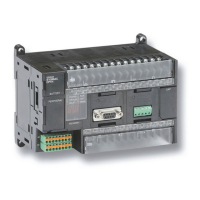5
General Instruction Characteristics Section 1-1
1-1-4 Instruction Location and Execution Conditions
The following table shows the locations in which instructions can be pro-
grammed. The table also shows when an instruction requires an execution
condition and when it does not. Refer to
SECTION 2 Summary of Instructions
for details on specific instructions.
In addition to these instructions, the CS/CJ-series PLCs are equipped with
block programming instructions. Refer to the description of the block program-
ming instructions for details.
Note If an execution condition does not precede an instruction that requires one, a
program error will occur when the program is checked from a Peripheral
Device.
1-1-5 Inputting Data in Operands
Operands are parameters that are set in advance with the I/O memory
addresses or constants to be used when the instruction is executed. There
are basically three kinds of operands: Source operands, destination oper-
ands, and numbers.
! @ MOV
Instruction mnemonic
Up-differentiation variation
Immediate-refreshin
variation
Instruction type Location Execution
condition
Format Examples
Input Instructions
that start
logic
conditions
At the left bus or at
the start of an
instruction block
Not required LD, LD TST, and input com-
parison instructions such as
LD >
Connecting
instructions
Between a starting
instruction and out-
put instruction
Required AND, OR, AND TST, input
comparison instructions such
as AND >, UP, DOWN, NOT
Output At the right bus Required The majority of instructions
(such as OUT and MOV)
Not required Instructions such as END,
JME, FOR, and ILC
Operand Usual
code
Contents
Source Address containing
the data or the data
itself
SSource
operand
Source data other than
control data
C Control
data
Control data with a bit
or bits controlling
instruction execution
Destination Address where the
data will be stored
D ---
Number Contains a number
such as a jump num-
ber or subroutine
number.
N ---
JMP
&3
#0000
D00000
MOV
S (Source)
D (Destination)
N (Number)

